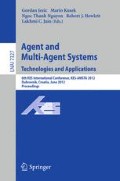Abstract
A multi-agent system consists of a group of interacting autonomous agents. The key problem in such a system is coordination and cooperation, i.e. how to ensure that individual decisions of the agents result in jointly optimal decisions for the overall system. This problem becomes even more serious when the number of the agents is large. Holonic model is an effective method to manage large scale problems. In holonic approaches, the formation of the initial holons is very critical and has a great influence on their performance and effectiveness. In this paper, we use a graph based modelling approach to group a population of agents with a greedy method, driven by a very simple and effective quality measure. The proposed method is evaluated by applying it to an urban traffic problem as a case study and it is shown the proposed method produces better results.
Access this chapter
Tax calculation will be finalised at checkout
Purchases are for personal use only
Preview
Unable to display preview. Download preview PDF.
References
Weiss, G.: Multiagent Systems: A Modern Approach to Distributed Modern Approach to Artificial Intelligence. MIT Press (1999)
Theocharopoulou, C., Partsakoulakis, I., Vouros, G.A., Stergiou, K.: Overlay networks for task allocation and coordination in dynamic large-scale networks of cooperative agents. In: Proc. of 6th International Joint Conference on Autonomous Agents and Multi Agent Systems, Hawaii, pp. 295–302 (2007)
Irandoust, H., Benaskeur, A.R.: Multi-organizational structures. In: Proc. of Association for the Advancement of Artificial Intelligence, Chicago, pp. 25–33 (2008)
Tianfield, H.: A new framework of holonic self-organization for multi-agent systems. In: Proc. of IEEE International Conference on Systems, Man, and Cybernetics, Montreal, pp. 753–758 (2007)
Koestler, A.: The Ghost in the Machine. Hutchinson (1967)
Rodriguez, S., Hilaire, V., Koukam, A.: Towards a holonic multiple aspect analysis and modeling approach for complex systems: Application to the simulation of industrial plants. Simulation Modelling Practice and Theory 15, 521–543 (2007)
Rodriguez, S., Hilaire, V., Koukam, A.: Formal specification of holonic multi-agent. In: Proc. of International Conference on Computational Science, pp. 719–726 (2005)
Deen, S.M.: A cooperation framework for holonic interactions in manufacturing. In: Proc. of the Second International Working Conference on CKBS, pp. 103–124 (1994)
Burckert, H.J., Fischer, K., Vierke, G.: Transportation scheduling with holonic mas - the teletruck approach. In: 3d International Conference on Practical Applications of Intelligent Agents and Multiagents, pp. 577–590 (1998)
Rodriguez, S., Hilaire, V., Koukam, A.: Towards a methodological framework for holonic multi-agent systems. In: Proc. of Fourth International Workshop of Engineering Societies in the Agents World, London, pp. 179–185 (2003)
Ulieru, M., Geras, A.: Emergent holarchies for e-health applications: a case in glaucoma diagnosis. In: Proc. of 28th Annual Conference of the Industrial Electronics Society, vol. 4, pp. 2957–2961 (2002)
Brandes, U., Delling, D., Gaertler, M., Gorke, R.: On finding graph clusterings with maximum modularity. In: Proc. of 33rd International Workshop on Graph-Theoric Concepts in Computer Science, pp. 121–132 (2007)
Schaeffer, S.E.: Survey graph clustering. Computer Science Review, 27–64 (2007)
Kok, J.R., Hoen, P.J., Bakker, B., Vlassis, N.: Utile coordination: Learning interdependencies among cooperative agents. In: Proc. of IEEE Symposium on Computational Intelligence and Games, Colchester, pp. 29–36 (2005)
Melo, F.S., Veloso, M.: Learning of coordination: Exploiting sparse interactions in multiagent systems. In: Proc. of 8th International Conference on Autonomous Agents and Multi Agent Systems, Budapest, pp. 773–780 (2009)
Doniec, A., Mandiau, R., Piechowiak, S., Espie, S.: A behavioral multi agent for road traffic simulation. Engineering Applications of Artificial Intelligence 21, 1443–1454 (2008)
Hirankitti, V., Krohkaew, J., Hogger, C.: A multi-agent approach for intelligent traffic-light control. In: World Congress on Engineering, London (2007)
Zhang, H.T., Yu, F., Li, W.: Step-coordination algorithm of traffic control based on multi-agent system. International Journal of Automation and Computing 6, 308–313 (2009)
Hu, M.B., Jiang, R., Wu, Y.H., Wang, W.X., Wu, Q.S.: Urban traffic from the perspective of dual graph. The European Physical Journal B(63), 127–133 (2008)
Chen, S.W., Yang, C.B., Peng, Y.H.: Algorithms for the traffic light setting problem on the graph model. In: Taiwanese Association for Artificial Intelligence, pp. 1–8 (2007)
Author information
Authors and Affiliations
Editor information
Editors and Affiliations
Rights and permissions
Copyright information
© 2012 Springer-Verlag Berlin Heidelberg
About this paper
Cite this paper
Abdoos, M., Esmaeili, A., Mozayani, N. (2012). Holonification of a Network of Agents Based on Graph Theory. In: Jezic, G., Kusek, M., Nguyen, NT., Howlett, R.J., Jain, L.C. (eds) Agent and Multi-Agent Systems. Technologies and Applications. KES-AMSTA 2012. Lecture Notes in Computer Science(), vol 7327. Springer, Berlin, Heidelberg. https://doi.org/10.1007/978-3-642-30947-2_42
Download citation
DOI: https://doi.org/10.1007/978-3-642-30947-2_42
Publisher Name: Springer, Berlin, Heidelberg
Print ISBN: 978-3-642-30946-5
Online ISBN: 978-3-642-30947-2
eBook Packages: Computer ScienceComputer Science (R0)

